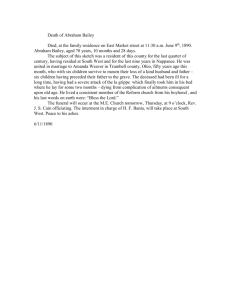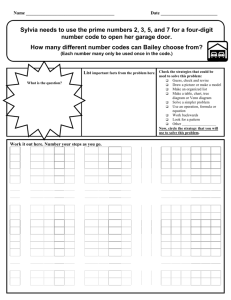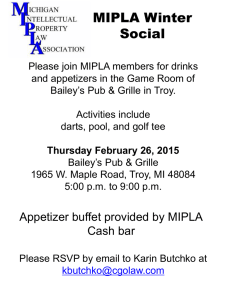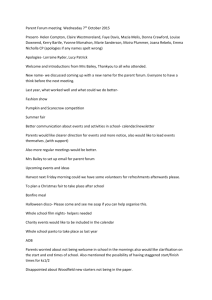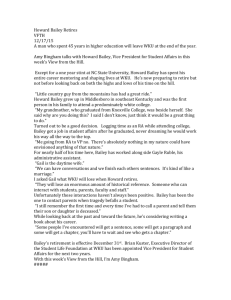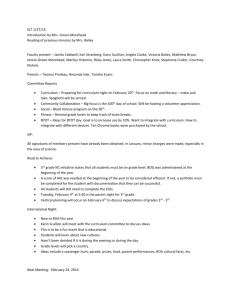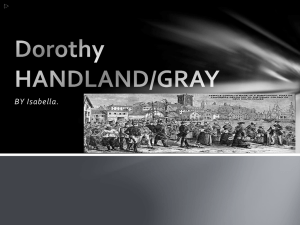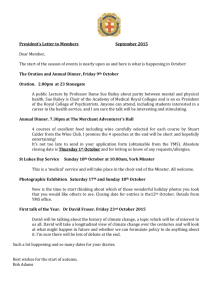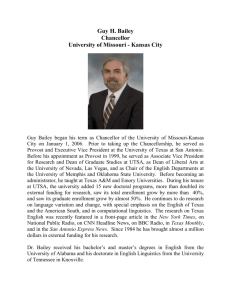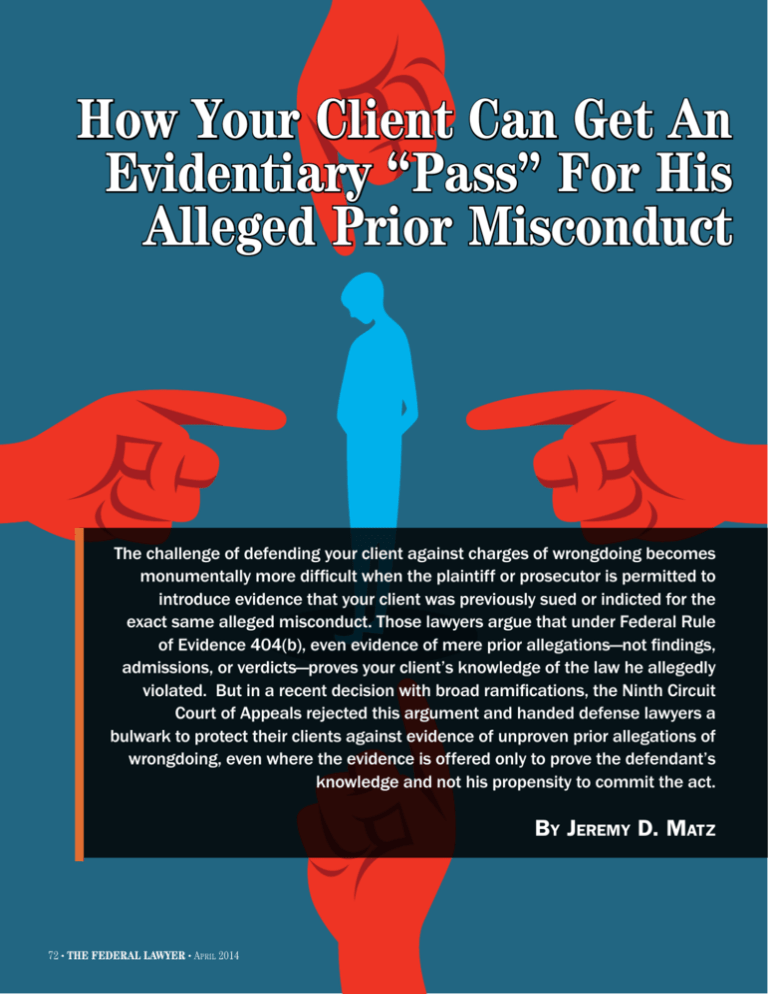
How Your Client Can Get An
Evidentiary “Pass” For His
Alleged Prior Misconduct
The challenge of defending your client against charges of wrongdoing becomes
monumentally more difficult when the plaintiff or prosecutor is permitted to
introduce evidence that your client was previously sued or indicted for the
exact same alleged misconduct. Those lawyers argue that under Federal Rule
of Evidence 404(b), even evidence of mere prior allegations—not findings,
admissions, or verdicts—proves your client’s knowledge of the law he allegedly
violated. But in a recent decision with broad ramifications, the Ninth Circuit
Court of Appeals rejected this argument and handed defense lawyers a
bulwark to protect their clients against evidence of unproven prior allegations of
wrongdoing, even where the evidence is offered only to prove the defendant’s
knowledge and not his propensity to commit the act.
By Jeremy D. Matz
72 • The Federal Lawyer • April 2014
S
uppose you represent a movie studio
that owns the copyright in an old film.
You learn that a film aficionado, claiming that the movie is in the public domain,
has uploaded it to his website and—via social
media and e-mail blasts—is encouraging people to watch it. You send him a letter with
proof of your client’s copyright. Your letter
also quotes from the federal Copyright Act
and describes how the aficionado is violating
it. Defiantly, the aficionado burns the film
onto DVDs and starts selling copies over the Internet. You sue in
federal court on behalf of your client, seeking enhanced statutory
damages based on willful infringement. As you prepare for trial,
you would probably assume that the admission into evidence of
the cease-and-desist letter (with proof that you sent it), to prove
that the defendant knew full well that his DVD selling illegally
infringes upon your client’s copyright, is a foregone conclusion.
Now suppose you represent a criminal defendant charged with
willfully making a false statement on his tax return. The Department of Justice alleges that in the 2010 tax year, your client illegally
sheltered hundreds of thousands of dollars of income in bank accounts in Brazil. Your client wants a trial. He earned the disputed
income entirely in Brazil from a Brazilian company in which he held
only an indirect interest and that did business only in that country.
He tells you that he honestly did not believe he had to report the
money on his U.S. tax return. But the government has some heavy
evidence against your client: in the 2007 tax year, under nearly
identical circumstances, he had earned—but had not reported—
substantial income, on that occasion from an Argentinian company.
After an audit of your client’s 2007 tax return, the IRS had issued
him a Revenue Agent’s Report, informing him that the income
was federally taxable, notwithstanding his contention that it was
earned and kept overseas. Without admitting liability, your client
had settled the audit and paid back taxes, penalties, and interest.
The federal prosecutor notifies you that she will offer the 2007 IRS
document to prove your client’s knowledge that the 2010 Brazilian
income was taxable in the United States. Is the prosecutor right
that the Revenue Agent’s Report is admissible for that purpose?
Not necessarily, based on the rationale of a 2-1 Ninth Circuit decision in August 2012 that could well have far-reaching
evidentiary implications favoring individual and corporate defendants in civil and criminal federal cases. Nor, under that decision, is it at all clear that the movie studio’s cease-and-desist letter is admissible in the copyright case. Under the Federal Rules
of Evidence, the Ninth Circuit held, an earlier Securities and Exchange Commission (SEC) complaint charging a defendant with
a civil violation of a securities regulation could not be admitted
in a later criminal case against the same defendant for violating
the exact same securities regulation on a subsequent occasion,
even to prove that the defendant knew about the regulation.
The Bailey Decision
The case is United States v. Bailey.1 Before a public company can issue or sell stock, the company must register it with
the SEC. To register the stock, the company generally must make
voluminous and detailed disclosures about its past performance,
key personnel, future business plans, how it intends to use the
proceeds from the stock offering, and many other matters. However, SEC Rule S-8 provides an exception for stock issued to the
company’s employees, consultants, or advisers.2 If such individuals provide bona fide services to the company, the company may
compensate them in stock without making the full disclosures.
Once Rule S-8 stock is issued, it is fully and freely tradable on the
open market. But stock issued in violation of the rule is deemed
not to be registered, meaning that it cannot be legally sold.
Bailey was the president and CEO of a publicly traded health
supplements company called Gateway Distributors. He was criminally charged under 15 U.S.C. §§ 77e and 77x with illegally selling
unregistered securities, namely, Gateway stock issued in violation
of Rule S-8. The government alleged that Bailey illegally issued
several hundred thousand dollars of Rule S-8 Gateway stock to
a man named Owens, not for any bona fide consulting services,
but instead to enable Owens to sell the stock for Gateway’s and
Bailey’s benefit. The indictment charged that Bailey used part of
the proceeds to buy a hunting lodge in Utah. Bailey defended on
the ground that Owens did in fact render legitimate consulting
services to Gateway, making it perfectly legal for Bailey to issue
Rule S-8 stock to Owens.
The problem for Bailey was that two years before he issued the
stock to Owens, he had issued billions of shares of Rule S-8 stock
in Gateway to a different individual and had been sued by the SEC
for that alleged Rule S-8 violation. The SEC complaint quoted the
rule’s requirements, including that Rule S-8 stock could be issued
only to employees and consultants for bona fide services rendered
and that it could not be issued to raise capital for the company.
Bailey had settled the lawsuit without admitting any liability.
April 2014 • The Federal Lawyer • 73
In Bailey’s criminal trial, the government moved in limine to
admit the SEC complaint under Federal Rule of Evidence 404(b),
which provides that “[e]vidence of a crime, wrong, or other act[,
although] not admissible to prove a person’s character in order to
show that on a particular occasion the person acted in accordance
with the character … may be admissible for another purpose, such
as proving motive, opportunity, intent, preparation, plan, knowledge,
identity, absence of mistake, or lack of accident.” The government
noted that the criminal securities offense required proof that Bailey
had acted “willfully,” which the Ninth Circuit has defined in securities cases to mean “intentionally undertaking an act that one knows
to be wrongful,” although not necessarily an act that one specifically
knows to be unlawful or illegal in the sense of a violation of a law on
the books.3 The government argued that the SEC’s filing and service
of the lawsuit on Bailey was an “other act,” admissible under Rule
404(b) to prove Bailey’s knowledge of the securities rule and the
wrongfulness of his conduct, as well as his intent and lack of mistake.
Bailey fought the motion. He announced that he would not defend
the criminal case on the ground that his conduct was unknowing, mistaken, accidental, or not willful. Indeed, he acknowledged that, by the
time of the disputed transactions with Owens, he knew full well that
Rule S-8 stock may only be issued in exchange for bona fide services.
He noted that the government would be introducing his under-oath
admission to the SEC that he knew about Rule S-8 and that he would
confirm this knowledge in his opening statement. Rather than defend
on the ground of ignorance or an innocent mistake, Bailey intended to
show that Owens actually did provide services to justify his receipt of
the stock. In light of his defense, Bailey argued that what the government really wanted was for the jury to draw the kind of impermissible
character/propensity inference that Rule 404(b) forbids: that because
Bailey had “done it before” as alleged in the SEC complaint, he must
have “done it again” as charged in the criminal indictment.
Citing the general rule that the party with the burden of proof
may prove its case with the evidence of its choice, notwithstanding
the opponent’s offer to admit certain facts,4 the government replied
that the SEC complaint was still admissible in its case in chief. The
district court noted that Bailey had not formally stipulated in the
criminal case that he knew of Rule S-8 and its requirements at the
time he issued the stock to Owens and that in the absence of any
such stipulation, the government could “introduce just the fact of
the SEC complaint … for the purpose of showing that [Bailey] certainly knew of what he was doing, that it was illegal.” Bailey was convicted of two counts of illegally issuing unregistered stock to Owens.
He was sentenced to 30 months in federal prison.
In an opinion written by Judge Betty B. Fletcher and joined by Judge
Andrew J. Kleinfeld, the Ninth Circuit vacated Bailey’s conviction, holding that the government had offered the SEC complaint to prove Bailey’s
intent to violate Rule S-8, and that admitting it for that purpose was nonharmless error. The court focused on the third prong of the Ninth Circuit’s four-prong test that determines whether an “other act” is admissible under Rule 404(b): whether the evidence is sufficient to support a
finding that the defendant committed the other act. In light of its theory
that the SEC complaint should be admitted simply to prove that Bailey
knew what Rule S-8 required and that he intended to violate the rule in
the stock sale to Owens, the prosecution contended that the “other act”
at issue was not any act that Bailey himself had committed (including
his alleged violation of Rule S-8, as described in the SEC lawsuit), but
rather an act that the SEC had committed: the act of suing Bailey and
74 • The Federal Lawyer • April 2014
serving him with the complaint. But the Ninth Circuit rejected this position, holding that there had to be sufficient evidence to support a jury
finding that Bailey actually had violated Rule S-8 earlier. The court held
that there was no such evidence: the SEC lawsuit was merely an accusation, which Bailey had settled with no admission of liability.5
The Bailey Dissent
In a vigorous dissent, Judge Milan D. Smith agreed with the government’s position that the “other act” at issue was the service of the
SEC complaint itself, not Bailey’s commission of the violation alleged
in it. In his view, the SEC complaint “apprised Bailey of the pertinent
prohibitions and requirements of Rule S-8,” and thus was properly
admitted to prove Bailey’s knowledge of the rule, regardless of his
intent to violate it. Whether Bailey actually did the things the SEC
alleged he had done was entirely beside the point.6 Judge Smith’s approach was analogous to the admission of an out-of-court statement
to prove its effect on the listener (especially the listener’s knowledge
of a key fact after hearing the statement), rather than to prove its
truth. Notwithstanding a hearsay objection, courts routinely uphold
the admission of documents for that nontruth purpose.7
Knowledge Versus Intent
The Bailey majority held that the government had used the SEC
complaint to prove Bailey’s intent to violate Rule S-8, and rejected
the argument that the complaint had been admitted only to prove his
knowledge of the rule. But in the key passage likely to have the greatest impact in future cases, the majority went even further than that:
It must be said, though, that [the SEC] complaint would not
establish [Bailey’s] knowledge even if the prosecution had purported to use it only for that reason. All a complaint establishes
is knowledge of what a plaintiff claims. It does not establish the
truth of either the facts asserted in the complaint, or of the law
asserted in the complaint. Since the previous complaint was
never proved, nor was the truth of any of it conceded, it could
not have established knowledge of the law. A complaint may
state that cars driving southbound are required to stop at the
intersection of 1st and Main, and that the defendant did not
stop. But such a complaint establishes neither that southbound
vehicles have a duty to stop, nor that the defendant failed to
stop. Likewise, the SEC complaint establishes neither [Bailey’s]
knowledge of the law nor a past wrongful act.8
In future cases, prosecutors and civil plaintiffs seeking to introduce a document such as a complaint or a cease-and-desist letter
could attempt to skirt this passage by offering the document solely
to prove a defendant’s knowledge, as opposed to his intent. This
theory of admissibility would depend on the quoted “knowledge”
passage from Bailey being dicta.
Although lawyers and judges often use the terms “knowledge” and
“intent” interchangeably, in fact they mean different things, and “it is
better to draw a distinction between intent (or purpose) on the one
hand and knowledge on the other.”9 Indeed, Judge Smith in dissent
criticized the Bailey majority for “incorrectly conflat[ing] the concepts of intent and knowledge to argue that the [SEC] Complaint was
used essentially as propensity evidence” in violation of Rule 404.10 In
an unrelated case also titled United States v. Bailey, the Supreme
Court noted that a person acts with knowledge if he is aware that a
given result is practically certain to follow from his conduct (whether
he desires it or not), whereas he acts with intent or purpose if he consciously desires that result (whatever the likelihood that his conduct
will actually cause it).11 In this sense, intent can be viewed as a higher
and more difficult to prove mental state than knowledge.
On the issue of knowledge, an earlier allegation that a defendant
did something and that a particular consequence ensued—if the defendant was aware of that allegation—could well support an inference
that when he later did the same thing again he knew what would come
of it, whether he ever committed the earlier act or not. Imagine that
my south-side neighbor’s lawsuit accuses me of failing to clean out my
backyard sump pump, causing the drainage system to back up and
flood my neighbor’s house. If a year later, my clogged drainage system
causes flooding on the other side of my house, my north-side neighbor
could introduce the earlier lawsuit to prove that I knew what could
happen if I neglected to clean out the pump, even if in fact I maintained it properly the year before. By analogy in Bailey, the earlier
SEC allegation that Bailey had violated Rule S-8 by issuing Gateway
stock could support an inference that when he later issued Gateway
stock to Owens, he knew what Rule S-8 proscribed. Judge Smith’s
view in dissent was that because the SEC complaint had been served
on Bailey, this inference could be justified even if Bailey never had issued stock illegally in the past as the SEC had charged.12
On the issue of intent, if a defendant actually committed a past act
(as opposed to merely being accused of committing it) and saw a particular result flow from it, there is a strong inference that he hoped for
the same result when he did it again. By analogy in Bailey, if Bailey in
fact had violated Rule S-8 by issuing Gateway stock on the earlier occasion, resulting in easy but illegal money to the company and to himself,
one could easily infer that he consciously desired the same outcome
when he issued Gateway stock to Owens. But where, as in Bailey, a
defendant is only accused of a past act—meaning that neither the act
nor its result was ever proven or admitted by him—then any inference
that he intended its result when he allegedly committed the same act
later is far weaker. If all that happened last year was that my south-side
neighbor sued me—in other words, if there was no proof that my conduct actually caused his property to flood—that mere allegation would
not tend to prove that I wanted my north-side neighbor’s property
to flood this year, especially if I conceded knowledge that insufficient
maintenance could collaterally damage my neighbors’ properties. Only
my actual disregard for my drainage system and the ensuing damage to
my south-side neighbor’s property could demonstrate that I purposely
flooded my north-side neighbor’s home.
Thus, the proponents of evidence such as a complaint or a ceaseand-desist letter to prove knowledge would argue that the “knowledge”
passage in Bailey is mere dicta, in light of the majority’s holding that
the government used the SEC complaint to show that Bailey intended
to violate Rule S-8 when he issued stock to Owens. The proponents’
argument would be that because the Bailey majority found the prosecution wrongly used an unproven past SEC allegation as a basis to argue
Bailey’s later intent to break Rule S-8—an inference that, when based
on a mere accusation, is weak at best—the majority’s sweeping language
about the uselessness of the SEC complaint to prove his knowledge of
the rule’s provisions was unnecessary to the holding. A document that
constitutes nothing more than an allegation might be incapable of establishing the higher mental state of intent, the proponents would contend,
but it certainly can establish the lower mental state of knowledge.
But for three reasons, the key passage in Bailey is anything but
dicta. First, the majority squarely addressed the government’s and
Judge Smith’s contention, acknowledging that “there is some logic to
the argument that [the SEC complaint] shows that [Bailey] was on
notice of the type of prohibited conduct,” but nonetheless holding
that “this is not enough. The prosecution was still required to prove
that the evidence was sufficient to support a finding that Bailey committed the act charged in the complaint. This a mere complaint cannot do.”13 Second, if the SEC complaint were sufficient to establish
Bailey’s knowledge of the rule, then his conviction should have been
affirmed. On evidentiary issues, the Ninth Circuit generally affirms on
any basis supported by the record, even if the district court’s decision was based on a different or even unfounded ground.14 Under this
long-established principle, even the erroneous admission of the SEC
complaint to demonstrate Bailey’s intent would not have been reversible if the complaint could also demonstrate his knowledge. Third, in
a petition for panel rehearing, the government—even while not challenging the holding—specifically asked the Ninth Circuit to eliminate
the “knowledge” passage, or at least modify it in a footnote. In November 2012, the panel unanimously denied the government’s petition.
Looking Ahead: The Future Influence of Bailey
At least in the Ninth Circuit, there may well be significant ramifications, far beyond criminal securities fraud cases, from Bailey’s holding that a defendant’s previous receipt of a complaint alleging a law
violation has no bearing on his knowledge of the law that he allegedly
broke. After all, in Bailey the complaint was a formal lawsuit brought
by the very federal regulatory agency responsible for enforcing the
law allegedly violated, and it was served on the defendant. Even then,
the court held, the complaint did not establish that the law was what
the agency said it was, or that the defendant knew what the law was.
By analogy in the film piracy case, the cease-and-desist letter
would not tend to prove the defendant’s knowledge that the Copyright Act prohibited his mass DVD sales. The act authorizes enhanced
statutory damages for willful copyright infringement.15 To prove willfulness, a plaintiff must show that the defendant was actually aware
of the infringing activity—i.e., that he knew he was infringing—or that
the defendant’s actions were the result of reckless disregard for, or
willful blindness to, the copyright holder’s rights.16 The movie studio’s
cease-and-desist letter alleged that the studio held the copyright to
the film, described in detail how the defendant was infringing it, and
even quoted the Copyright Act verbatim. But the SEC complaint in
Bailey did the exact same things with regard to Rule S-8 and Bailey’s
violation of it. The cease-and-desist letter would not tend to establish
the infringer’s knowledge of the Copyright Act any more than the SEC
complaint demonstrated Bailey’s knowledge of the SEC regulation.
In the criminal tax case, the government would have to prove
that the defendant willfully underreported his income, which in the
tax context means a voluntary, intentional violation of a known legal
duty.17 In other words, the government would have to prove that the
defendant knew he had a legal duty to report the income he made in
Brazil in 2010. In the 2007 Revenue Agent’s Report, the IRS had told
the defendant in no uncertain terms that he had a legal duty to report
the income he made that year in Argentina. But even if the relevant
facts of the Argentinian and of the Brazilian income were exactly the
same, the IRS’ earlier notice to the defendant would not prove that the
law required him to report foreign income, or that the defendant was
aware of that legal duty, any more than the SEC complaint in Bailey
proved a legal obligation or the defendant’s knowledge of it.
April 2014 • The Federal Lawyer • 75
Just like a complaint, these kinds of letters and notices typically
contain a mixture of factual claims (“we own this movie but you sold
copies,” “you sheltered your income”) and legal claims (“the law
says you can’t do what you did”). Some crimes and causes of action
require proof that the defendant knew what the governing law provided. But Bailey says that even a government complaint that sets
forth the governing law and that is served on the defendant does not
constitute such proof: a complaint “does not establish the truth of
either the facts [or of the law] asserted in [it].”
In the approximately 18 months since the Ninth Circuit decided
Bailey, no court has yet relied on its reasoning to exclude evidence
or to reverse a verdict based on the erroneous admission of evidence
similar to the SEC complaint.18 However, litigants and practitioners
are increasingly aware of the decision’s potential impact. In a federal
criminal case in Nevada, Tarl Brandon was convicted of mortgage fraud
and sentenced to 14 years in prison. Brandon’s appellate brief, filed in
the Ninth Circuit in November 2013, describes how his ex-girlfriend
testified that he had “been through a federal investigation before for
mortgage fraud” and for that reason wanted to keep his name off of
documents. Over his objection and request for a mistrial, the ex-girlfriend’s testimony was admitted pursuant to Rule 404(b). On appeal,
Brandon cites Bailey extensively, arguing that admitting the testimony
was reversible error because “the proof of any prior bad act … was even
more attenuated than in Bailey. It was not even clear that there was
any prior investigation at all, much less that Brandon had actually done
anything wrong …. Moreover, just as in Bailey, even assuming there
had been a prior investigation, that is insufficient to support a finding
that Brandon committed the prior act at issue, as is required to be
admissible under Rule 404(b). As in the case of the filing of a complaint,
the mere instituting of an investigation does not provide any evidence
that the defendant actually committed any crime.”19
Thus, in the Ninth Circuit after Bailey, parties and attorneys will
likely find it more difficult than ever to introduce complaints, letters, notices, and similar documents to prove the opposing party’s knowledge.
Epilogue
There is an interesting denouement to Bailey. After his convictions
were vacated, the government elected to retry him in June 2013. The
second time, of course, the government was barred from introducing
the SEC complaint. However, before the retrial, Bailey entered into a
detailed “Stipulation Regarding SEC Form S-8.” The stipulation described how Rule S-8 operates and what it permits and prohibits. It also
stated: “At all times relevant to the charges in this case, Bailey knew and
understood the rules pertaining to SEC Form S-8.” The stipulation thus
conclusively established Bailey’s knowledge, but it still left the government having to prove his willfulness, which in turn required proof of
his intent to violate Rule S-8.20 According to the Ninth Circuit majority
that vacated his first conviction, that should have been quite a difficult
hurdle for the government to clear. Bailey’s intent “was the sole issue in
the case,” said the majority, and “the government’s case against Bailey
[without the SEC complaint] was weak.”21 Hence the majority’s conclusion that the error in admitting the complaint was not harmless. But after a retrial that lasted only two days, a jury once again convicted Bailey
of the same two counts of illegally selling unregistered securities. The
majority’s decision ultimately did not benefit Bailey, but it still stands as
precedent for litigators to use as an effective shield against the admission of evidence of their clients’ alleged prior misconduct.
76 • The Federal Lawyer • April 2014
Jeremy D. Matz is a partner at Bird
Marella Boxer Wolpert Nessim Drooks &
Lincenberg, a litigation-only law firm in
Los Angeles, where he focuses on complex
civil litigation of all kinds and white collar criminal defense. Before joining Bird
Marella, Matz was an assistant U.S. attorney and securities fraud coordinator at
the U.S. Attorney’s Office in Los Angeles. He
also teaches evidence at the University of Southern California,
Gould School of Law.© 2014 Jeremy D. Matz. All rights reserved.
Endnotes
United States v. Bailey, 696 F.3d 794 (9th Cir. 2012).
17 C.F.R. § 239.16b.
3
United States v. Tarallo, 380 F.3d 1174, 1187-88 (9th Cir. 2004);
United States v. English, 92 F.3d 909, 914-15 (9th Cir. 1996).
4
Old Chief v. United States, 519 U.S. 172, 186-87 (1997).
5
Bailey, 696 F.3d at 799-802, 805.
6
Bailey, 696 F.3d at 805, 807 (Smith, J., dissenting).
7
See, e.g., United States v. Dupree, 706 F.3d 131, 137-38 (2nd
Cir. 2013) (in federal criminal bank fraud case, TRO in related state
civil lawsuit prohibiting defendant from diverting funds was admissible nonhearsay because offered not for the truth of its assertions,
but only as evidence that, when defendant withdrew money, he knew
of and intended to violate contractual obligation to maintain funds at
victim bank).
8
Bailey, 696 F.3d at 802.
9
LaFave, W.R., Criminal Law § 3.5 (4th Ed. 2003).
10
Bailey, 696 F.3d at 808 (Smith, J., dissenting).
11
United States v. Bailey, 444 U.S. 394, 404 (1980); see also
Kawaauhau v. Geiger, 523 U.S. 57, 61-62 (1998) (intentional torts
generally require that the actor intend the consequences of an act,
not simply the act itself).
12
Bailey, 696 F.3d at 807-08 (Smith, J., dissenting).
13
Bailey, 696 F.3d at 801.
14
See, e.g., United States v. Morales, 720 F.3d 1194, 1201
(9th Cir. 2013) (analyzing whether government immigration forms
improperly admitted under business records hearsay exception
nonetheless were admissible under public records exception);
United States v. Alexander, 48 F.3d 1477, 1487 (9th Cir. 1995)
(document properly admissible under one hearsay exception even
though district court admitted it under a different exception).
15
17 U.S.C. § 504(c)(2).
16
Island Software and Computer Service, Inc. v. Microsoft
Corp., 413 F.3d 257, 263 (2nd Cir. 2005).
17
United States v. Pomponio, 429 U.S. 10, 12-13 (1976).
18
The few court decisions that have cited Bailey typically have
done so for basic statements of evidentiary law, such as to state
the Ninth Circuit’s four-prong Rule 404(b) test, see, e.g., United
States v. Ramos-Atondo, 732 F.3d 1113, 1123 (9th Cir. 2013), or to
state the rule that the erroneous admission of evidence is subject to
harmless error review, see, e.g., Estate of Barabin v. AstenJohnson, Inc., 740 F.3d 457, 464 (9th Cir. 2014).
19
United States v. Brandon, Appellant’s Opening Brief, 2013 WL
6407985 at *47-*52 (9th Circuit, Nov. 27, 2013).
20
Tarallo, 380 F.3d at 1188.
21
Bailey, 696 F.3d at 805.
1
2

